Currently we do not buy Swedish Kronas
SEK – Swedish Krona
Monetary System
1 Swedish krona (SEK) = 100 öre
2014 – 2019 Issues
The prefix letters indicate the year in which the banknote was printed (B = 2014, C = 2015, D = 2016, E = 2017, F = 2018, G = 2019, H = 2020). The two first digits of the serial number indicate the note’s location on the printing sheet. The final seven digits are the serial number.
Description: 20.00 SEK – Swedish Krona Size: 120 x 67 mm
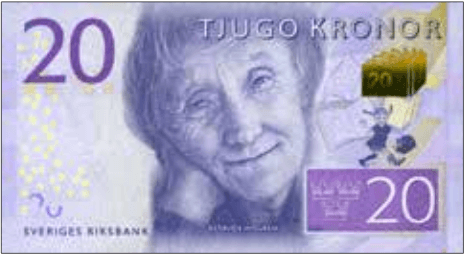
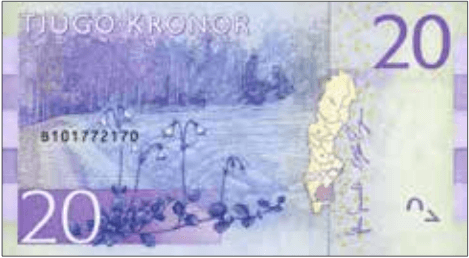
Purple. Front: Denomination as registration device; children’s writer, Astrid Lindgren; three crowns; open books and walking child, “Pippi Långstrump” (Pippi Longstocking); open book in gold-to-green SPARK. Back: Trees, road, and boulders in Småland, where Astrid Lindgren grew up; flowers; map of Sweden. Solid security thread. Watermark: Astrid Lindgren and electrotype 20. Printer: (Tumba Bruk). 120 x 67 mm. Paper.
Description: 50.00 SEK – Swedish Krona Size: 126 x 66 mm
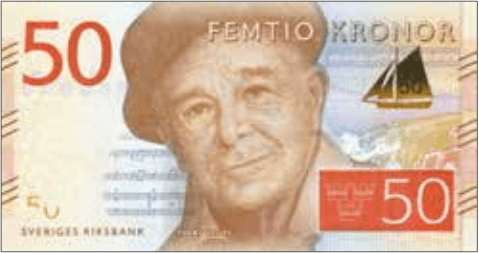
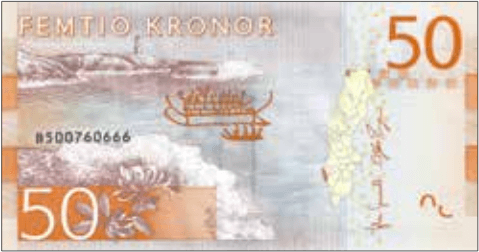
Yellow and orange. Front: Denomination as registration device; musical notes on scale; poet, composer, and artist, Evert Taube; three crowns; waterfall; sailboat in gold-to-green SPARK. Back: Flowers; lighthouse at Bohuslän, one of the many places from which Evert Taube drew inspiration; boats; map of Sweden. Solid security thread. Watermark: Evert Taube and electrotype 50. Printer: (Tumba Bruk). 126 x 66 mm. Paper.
Description: SEK – Swedish Krona Size: 133 x 66 mm
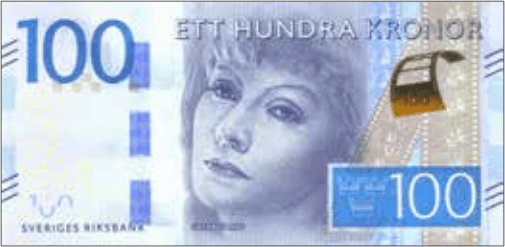
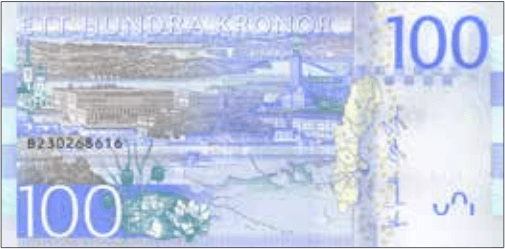
Blue. Front: Denomination as registration device; actress, Greta Garbo; three crowns; film stock; film in gold-to-green SPARK. Back: Stockholm, where Greta Garbo grew up; flowers; map of Sweden. Motion windowed security thread with crown and KR. Solid security thread. Watermark: Greta Garbo and electrotype 100. Printer: (Tumba Bruk). 133 x 66 mm. Paper.
Description: 200.00 SEK – Swedish Krona Size: 140 x 66 mm
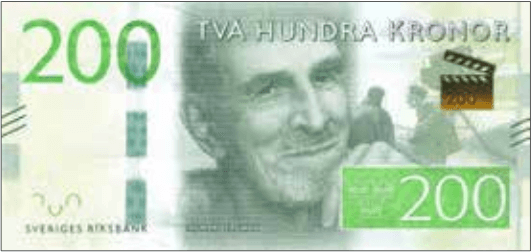
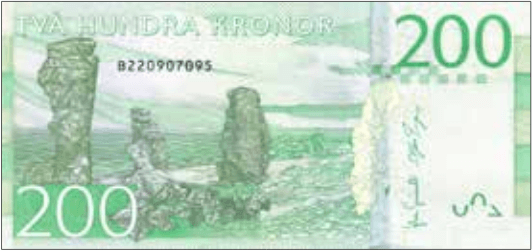
Green. Front: Denomination as registration device; film director, Ingmar Bergman; three crowns; Death (Bengt Ekerot) and Bergman conferring on set of The Seventh Seal with camera; clapperboard in gold-to-green SPARK. Back: Stone pillars at Gotland (Fårö), where Ingmar Bergman had his home; flowers; map of Sweden. Motion windowed security thread with crown and KR. Solid security thread. Watermark: Ingmar Bergman and electrotype 200. Printer: (Tumba Bruk). 140 x 66 mm. Paper.
Description: 500.00 SEK – Swedish Krona Size: 147 x 66 mm
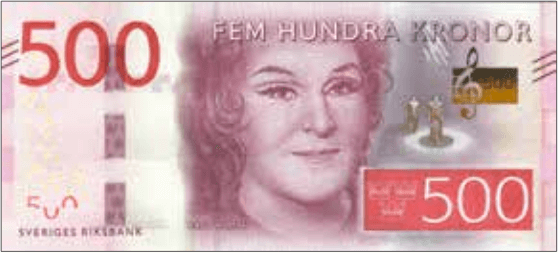
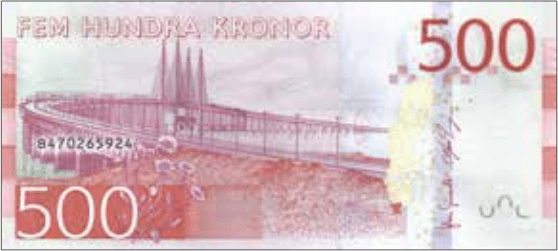
Red. Front: Denomination as registration device; singer, Birgit Nilsson; three crowns; standing singers; musical note in gold-to-green SPARK. Back: Øresundsbron bridge connecting Denmark and Sweden in Skåne, where Birgit Nilsson grew up; flowers; map of Sweden. Motion windowed security thread with crown and KR. Solid security thread. Watermark: Birgit Nilsson and electrotype 500. Printer: (Tumba Bruk). 147 x 66 mm. Paper.
Description: 1,000.00 SEK – Swedish Krona Size: 154 x 66 mm
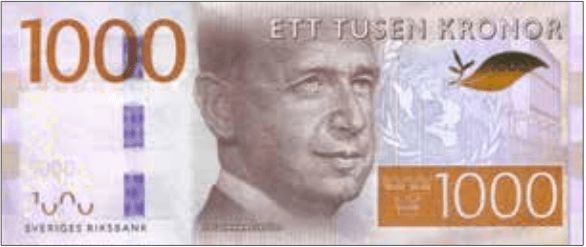
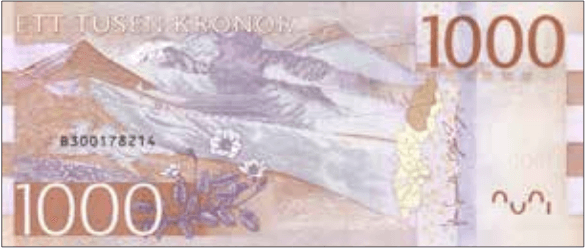
Gray-brown. Front: Denomination as registration device; UN Secretary-General and Member of the Swedish Academy, Dag Hammarskjöld; three crowns; United Nations seal; olive branch and leaf in gold-to-green SPARK. Back: Mountains in Lappland, an area of natural beauty of great interest to Dag Hammarskjöld; flowers; map of Sweden. Motion windowed security thread with crown and KR. Solid security thread. Watermark: Dag Hammarskjöld and electrotype 1000. Printer: (Tumba Bruk). 154 x 66 mm. Paper.
Bank of Stockholm
Stockholms Banco
King Charles X Gustav signed two 30-year charters on 30 November 1656 to create an exchange bank and a loans bank. The first of these (which opened in July 1657) took deposits for a fee (and accruing no interest) with the account owner later able to withdraw the money as cash or to write cheques. The second (which opened at the beginning of 1659) provided loans, financed by the bank owners and secured against property. These two departments were combined into Stockholms Banco (Swedish: Bank of Stockholm, SB) with Johan Palmstruch as general manager.
Sweden at this time did not have a single currency, rather there was one daler minted in copper (kopparmynt) and another minted in silver (silvermynt). As the metal content of a copper daler had to be worth as much as that of a silver one, this meant that copper daler were large and heavy plate-sized coins. In practice, however, the silver daler was worth more and these were often hoarded, so generally only these large kopparmynt daler were commonly available.
